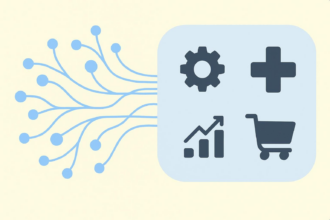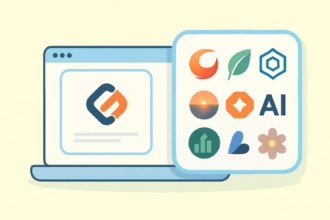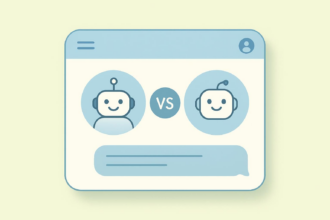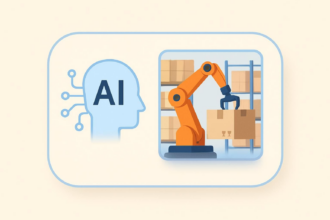Artificial intelligence (AI) in e-commerce was once a rare, boutique tool reserved for enterprise-level businesses with resources to spare. But as the technology has evolved, AI accessibility has reached anyone with an internet connection — including smaller businesses.
In retail, using AI is now a must to keep up with the competition. From personalizing shopping experiences to providing real-time analytics, AI tools are essential to sell your services or products online. Read on to learn why AI retail trends have made such a splash, what they can do, and how to take advantage of them for your business.
Why is AI a game-changer in e-commerce?
AI automates repetitive tasks, predicts customer behavior, and enhances personalization, helping businesses boost engagement and revenue.
Where is AI used in e-commerce?
AI is used throughout the online shopping process, both behind the scenes and with customers, for better customer support and experience.
- Chatbots and virtual assistants: Most customers are familiar with this use case. Jotform AI Agents, for example, can help customers navigate your website and answer frequently asked questions 24-7.
- Personalized product recommendations: AI can track and analyze customer activity for a customized website experience, such as tailored offers and product recommendations to boost conversion rates. For example, Kobo sends emails when a book on a user’s wish list goes on sale.
- Dynamic pricing strategies: AI e-commerce tools can track supply and demand to automatically adjust pricing and keep you competitive in dynamic markets. This is why you might notice prices change in your wish list for retailers like Amazon.
- Inventory forecasting and supply chain optimization: Supply chain tools like Oracle SCM use AI to make more accurate predictions about stock needs, as well as monitor inventory costs to reduce overhead and overstock.
- Customer churn analytics: AI-based analytics like Qualtrics can identify patterns and behavior for at-risk customers, suggesting customer retention strategies to improve loyalty.
How does AI help online retailers increase revenue?
AI can predict customer preferences, automate responses, and dynamically adjust pricing, leading to higher conversions and better retention.
Benefits of AI in e-commerce
It’s one thing to know what AI can help you do, but another to see the tangible outcomes. Because AI is always learning and improving from real customer data, its predictions and suggestions get better as time goes on.
Here are some of the most valuable ways e-commerce automation helps you optimize the customer experience to improve sales, engagement, and efficiency:
- Higher conversion rates: AI can target customers with more relevant calls to action, ads, recommendations, and promotional messaging to nudge them toward making a purchase. Even including AI search in organic marketing efforts can increase conversion rates nine times over.
- Improved customer engagement: AI chatbots can step in when your customer service team is offline or too busy, helping customers instantly so they’re less likely to bounce. Recent research shows that using AI to meet these customer expectations is the key to increasing engagement.
- Better decision-making: AI-driven analytics help businesses react strategically to customer and market trends in real time, like if one of your suppliers raises their prices.
- Lower operational costs: AI can automate the process of changing prices, managing inventory, finding better suppliers, and handling customer service tickets — reducing operational costs. In fact, PwC predicts that integrating AI can lower costs by 30% in some sectors.
- Reduced cart abandonment: AI can automatically implement re-engagement strategies, such as sending abandoned cart emails and reminders about chatbot messages, to recover lost sales.
Can AI help small e-commerce businesses?
Absolutely. AI tools level the playing field, giving small businesses access to automation, personalization, and analytics that were once only available to large retailers.
AI challenges in e-commerce and how to solve them
It seems like AI is everywhere, and there’s been a lot of pushback as the technology expands. Although AI is nothing to fear, it’s important to keep its limits in mind.
| Problem | Solution |
|---|---|
| AI collects customer data, raising concerns over what it’s doing with customers’ personal information. | Ensure GDPR/CCPA compliance, and be transparent about data usage with a clear privacy policy. |
| AI-powered tools can be expensive to implement before businesses see a return. | Start with affordable AI-powered SaaS tools, like testing Jotform’s AI Agents for free, before scaling. |
| Finding AI tools that are compatible with existing e-commerce platforms. | Use AI-ready e-commerce solutions and check for compatible API integrations before choosing which AI tools to use. |
| AI can’t replace human decision-making. | Use AI to pull general data insights and automate workflows, but always use human oversight for bigger decisions. |
| If AI is trained on biased data, it can make decisions that exclude certain customers. | Regularly audit AI algorithms and hire diversity, equity, and inclusion professionals to ensure fair and inclusive AI use. |
How can businesses adopt AI responsibly?
E-commerce brands should focus on transparency, ethical AI use, and customer trust when implementing AI solutions.
6 steps to implement AI successfully in e-commerce
When done correctly, the benefits of using AI tools far outweigh the risks. Follow these steps to reduce any AI hiccups and start reaping the benefits of AI e-commerce business models.
1. Identify business needs
Start your AI discovery process by brainstorming your business’s top concerns and goals. AI solutions for e-commerce can help you in a lot of ways, but you’ll need to identify measurable business metrics (like click-through and conversion rates) that a tool can help your business achieve so that you can pick out the right AI tool for your unique needs.
2. Choose the right AI tools
Right now, you could toss a stone and hit an AI tool. So, how do you find the one that will work for you? Spend some time researching different AI e-commerce tools based on their price and capabilities, taking advantage of free trials and demos. Use these test drives to explore different AI-powered chatbots, recommendation engines, and analytics platforms, and see their real potential before committing to a purchase.
3. Start with small pilots
Although it’s tempting to start using such a powerful tool everywhere possible, it’s important to try out AI in one area — like customer support or pricing — before expanding. This allows you to troubleshoot the product, learn how it works best, and measure its performance, protecting the other areas of your business in case it doesn’t work out.
4. Train staff
E-commerce AI tools make your employees’ jobs easier, but you still need to invest some time in training your employees on how to make the most of these new tools. Set up training, Q&A sessions, and resources to help your employees understand how to use new solutions, interpret outputs, and spot when AI might not be making the right decisions.
5. Monitor AI performance
Determine how you measure success for generative AI in e-commerce, such as how many employees are using it, whether it’s improving your customer satisfaction KPIs, or how much time it’s saving the average employee per week.
6. Scale gradually
Use performance data from your AI tool rollout to determine any next steps to scale it to other business areas. For example, if the team has noticed that an AI data analysis tool is great at managing stock but not as effective for predicting customer behavior, it makes more sense to expand the pilot to other operations tasks instead of testing out the customer service features.
How Jotform’s e-commerce AI Agents automate engagement and sales
Getting AI support for your e-commerce business can be simple. Tools like Jotform’s AI Agents can improve customer experience, streamline operations, and maximize your team’s productivity with fewer growing pains than solutions that claim to be one-size-fits-all.
Use chatbots to provide around-the-clock multichannel customer support, collect customer feedback, personalize the digital shopping experience, and more — supercharging your AI e-commerce strategy. Browse our e-commerce AI Agent templates for everything you need, from AI-driven order processing to talent acquisition. Below are just two of our most popular.
Jotform Online Shopping Survey AI Agents
Surveys are the gold standard for learning what customers really think, but respondents might hold back if they’re worried about the reaction from a real person asking them questions.
Jotform’s Online Shopping Survey AI Agent can collect customer feedback, analyze product preferences, measure user experience, and improve customer engagement consistently and accurately.
Jotform Apparel Order AI Agents
E-commerce AI makes it possible to scale more customized ordering experiences, bringing the luxury of shopping with an assistant to the digital age.
Jotform’s Apparel Order AI Agents work closely with customers and provide step-by-step product selection assistance for more accurate orders and fewer abandoned carts.
See how Jotform’s AI Agents can move the needle for your e-commerce business
AI in e-commerce is here to stay, so keep your business ahead of the curve. The future of online shopping belongs to businesses that augment human creativity and judgment with AI’s processing power and pattern recognition. And tools like AI chatbots for e-commerce are easy entry points for growing and staying competitive with this evolving technology.
Best of all, there are some tools that remove the traditional barriers to AI adoption like technical complexity and long implementation timelines, making automation accessible to businesses of any size. Jotform’s AI Agents are such tools — try them for free today.
This guide is for online store owners, e-commerce managers, DTC founders, digital marketers, merchandisers, operations and supply chain leads, customer support teams, and data analysts alike.








































































































Send Comment: